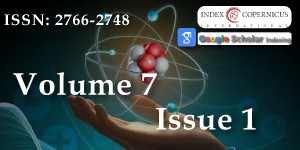Structural Morphology of Organic Waste-derived Fiber in X–band Frequency
Main Article Content
Abstract
Sawdust is a by-product or waste product of woodworking such as cutting, sanding, machining, planning, and routing. Saw dust consists of small woodcutting intending to study the structural morphology of organic waste fiber derived in an X-band frequency and synthesis of the rice dust and sawdust. The solid-state method was employed to mix the husk, to obtain the fine power, and the Fourier-transform infrared spectroscope was used to determine the sample absorption rate. The FTIR results show that the best samples are 6.5g and 6.5g rice bark and sawdust, with an absorbance rate of 86% and 14% transmission, which will be used for the manufacture of electronic and communication devices.
Article Details
Copyright (c) 2024 Abdullahi S, et al.

This work is licensed under a Creative Commons Attribution 4.0 International License.
The International Journal of Physics Research and Applications is committed in making it easier for people to share and build upon the work of others while maintaining consistency with the rules of copyright. In order to use the Open Access paradigm to the maximum extent in true terms as free of charge online access along with usage right, we grant usage rights through the use of specific Creative Commons license.
License: Copyright © 2017 - 2025 |  Open Access by International Journal of Physics Research and Applications is licensed under a Creative Commons Attribution 4.0 International License. Based on a work at Heighten Science Publications Inc.
Open Access by International Journal of Physics Research and Applications is licensed under a Creative Commons Attribution 4.0 International License. Based on a work at Heighten Science Publications Inc.
With this license, the authors are allowed that after publishing with the journal, they can share their research by posting a free draft copy of their article to any repository or website.
Compliance 'CC BY' license helps in:
| Permission to read and download | ✓ |
| Permission to display in a repository | ✓ |
| Permission to translate | ✓ |
| Commercial uses of manuscript | ✓ |
'CC' stands for Creative Commons license. 'BY' symbolizes that users have provided attribution to the creator that the published manuscripts can be used or shared. This license allows for redistribution, commercial and non-commercial, as long as it is passed along unchanged and in whole, with credit to the author.
Please take in notification that Creative Commons user licenses are non-revocable. We recommend authors to check if their funding body requires a specific license.
Robert W, Dragan E. Fundamentals of Power Electronics. 2nd ed. Kluwer Academic Publishers; 2001. 5-10.
Krishan KC. Composite Materials, Science and Engineering, Third Edition,12-20. New York Heidelberg Dordrecht London. 2012. ISBN 978-0-387-74364-6 ISBN 978-0-387-74365-3 (Ebook) DOI 10.1007/978-0-387-74365-3.
Sonnia ENM, ling TB, Png LS By-products of Rice Processing: an overview of health benefits and application. Rice Res. 2013; 1:1–11
Yakubu A, Ahmad F, Zulkifly A, Mohamad ZF, Suzan J. Dielectric Characterization of Oil Palm Fiber Reinforced Polycaprolactone Nickel Oxide Composite At Microwave. Procedia Environment Science. 2015; 30:273-278.
Yakubu A, Zulkifly A, Nor A, Ibrahim, Ahmad F. Reduction of Electromagnetic Interference Using ZnO-PCL Nanocomposites at Microwave Frequency. Advances in Materials Science and Engineering. 2015;4:7. Article ID 132509.

